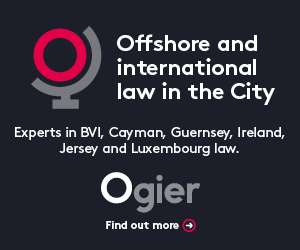
Securitisation and Cayman Orphan SPVs – Part Three
In the final article in a series of three, Paul Trewartha and Simon Lawrenson, Partners at Mourant Hong Kong, examine the key features of a securitisation vehicle and the advantages of utilising an Orphan SPV in the Cayman Islands for a securitisation transaction.
In the first article of the series Securitisation and Cayman Orphan SPVs – Part One, we briefly discussed what a securitisation is, the reasons for undertaking such a transaction and the key features and advantages of a Cayman Islands Orphan SPV, while the second article, Securitisation and Cayman Orphan SPVs – Part Two, discussed the steps to achieve bankruptcy remoteness through a Cayman Islands Orphan SPV in more detail. This third article focuses on the administration of a Cayman Islands Orphan SPV as it relates to a securitisation transaction as well as the Cayman Islands entities which can be used in a securitisation structure.
Administration of the Orphan SPV
An Orphan SPV in a securitisation transaction needs to appoint a number of service providers in order to administer the trust structure discussed in the first article, to ensure its independence and to enable its effective operation, including:
- share trustee;
- independent director(s);
- company secretary (if required); and
- registered office provider.
There are a range of corporate service providers based in the Cayman Islands which provide these services, including Mourant Governance Services Cayman Islands (MGS) which delivers a comprehensive range of fiduciary, administration, accounting and governance services through a dedicated team of experienced professionals in the Cayman Islands. MGS is a global network with offices in the Cayman Islands, Guernsey, Hong Kong and Jersey and is able to offer ’round the clock’ client service. MGS has comprehensive industry knowledge and experience with securitisation structures and other complex structured finance transactions, working on structured finance and asset finance transactions alongside of the world’s leading financial institutions.
In addition to providing independent directors, share trustee and foundation services and registered office services, MGS is able to offer a full range of fiduciary services which support the ongoing maintenance of an Orphan SPV, such as AML officer services, FATCA and CRS reporting services and listing agent services, ensuring the Orphan SPV is appropriately managed on a daily basis.
This is indicative of the widely recognised and well established financial and professional services centre that has developed in the Cayman Islands.
The use of segregated portfolio companies in securitisation
As discussed in the first two articles of this series, for multi-issuance securitisation issuers or otherwise, securitisations will be structured to ensure the documentation includes ring-fencing provisions to protect and preserve the relevant Underlying Assets for the benefit of the secured creditors. This approach is market-standard across a wide-range of jurisdictions and is widely accepted by regulatory authorities, listing exchanges and rating agencies.
Where there is a concern that the contractual ring-fencing may break down, or is otherwise unavailable or unenforceable, a Cayman Islands segregated portfolio company (SPC) can be utilised to address such concern. The Companies Act provides that a Cayman Islands exempted company can be registered as an SPC. The benefits of using an SPC in a securitisation transaction are discussed below.
Key features of an SPC
The attractiveness of using an SPC as a securitisation vehicle becomes evident upon examination of the legislative principles underpinning the creation of the SPC (which can be, and regularly are, incorporated as an orphan trust vehicle in the same manner as set out in the first two articles of this series). The Companies Act provides that an SPC is a single legal entity within which may be established various segregated portfolios. In practice, an SPC issuer can establish a new segregated portfolio for the issuance of each new tranche or series of Notes that it issues.
The assets and liabilities of each segregated portfolio established by an SPC are, pursuant to the Companies Act, legally separate from:
- the assets and liabilities of the other segregated portfolios established by that SPC; and
- the general assets and liabilities of that SPC which are not attributable to a specific segregated portfolio.
For more information on the Cayman Islands SPC, please see our guide on Cayman Islands segregated portfolio companies.
Why SPCs are used in securitisation – ring-fencing
The effect of the SPC regime in a securitisation context is to codify the ring-fencing concepts similar to those described in the second article of this series, such that the assets and liabilities of the SPC issuer which relate to a specific tranche or series of Notes issued by the SPC acting for the account of a specific segregated portfolio would be attributable only to that specific segregated portfolio.
Recourse of creditors
Creditors of the SPC acting for the account of a specific segregated portfolio would only have recourse to:
- the assets attributable to that specific segregated portfolio, and
- (unless specifically prohibited by the articles of association of the SPC) the SPC’s general assets, to the extent the assets of the specific segregated portfolio are insufficient to satisfy the liability to meet any claim against the SPC acting for the account of that specific segregated portfolio (in our experience, the articles of association typically expressly prohibit this).
Accordingly, where there is a shortfall, creditors of a specific segregated portfolio would not be permitted to make a claim against the assets of another segregated portfolio (which would typically relate to a separate tranche or series of Notes).
The benefits of using an SPC as an issuer is that the ring-fencing requirements are entrenched in statute rather than in contract (although in practice both levels of ring-fencing are relied upon) and this benefit is recognised in the Cayman Islands. While there are uncertainties relating to the recognition and application of the statutory segregation regime in a foreign court (this has not yet been tested), given it is embedded in statute, the statutory regime would bind non-consensual third parties who are not captured by the contractual ring-fencing (which only binds the parties to the securitisation transaction documents).
Limited liability companies – an additional structuring option
The Cayman Islands introduced the Limited Liability Companies Act (the LLC Act) in 2016 which permits the formation of a limited liability company (an LLC) in the Cayman Islands.
An LLC is an incorporated entity with separate legal personality but, unlike Cayman Islands exempted companies (and by extension, Cayman SPCs), it does not have share capital. Members’ liability is limited and capital accounts are permitted, whilst (similar to the freedoms afforded to partners of an exempted limited partnership) the members are free to determine amongst themselves in the LLC agreement how profits and losses are allocated and how and when distributions are made.
While LLCs are not typically utilized as an issuer in a securitisation structure, at the time the LLC Act was introduced it was contemplated that they could be used for a broader purpose within securitisation and structured finance matters. LLCs have, in the US context, been used as risk retention vehicles in collateralised loan obligation (CLO) issuances and it is helpful for market participants to understand that these entities provide an additional structuring option for certain securitisation arrangements.
For more information on the Cayman Islands LLC, please see our guide on Cayman Islands limited liability companies.
Other jurisdictional advantages of the Cayman Islands
The Cayman Islands provides a commercial and legal environment which is attractive to securitisation and capital market participants, most notably as a domicile of choice for incorporating an Orphan SPV issuer in a securitisation. Some of these advantages are set out below.
Tax neutrality
The Cayman Islands imposes no direct tax, meaning no corporation, income, capital gains or withholding taxes are levied on any company carrying on business within or outside of the Cayman Islands, making it a tax neutral jurisdiction.
The use of Cayman Islands based administrators means that Orphan SPVs are centrally managed and controlled in the Cayman Islands, which (subject to the appropriate tax analysis) should mean that the Orphan SPV will not be taxable in another jurisdiction solely on the basis that its “management” is based in that jurisdiction.
A further advantage which makes the Cayman Islands an attractive jurisdiction to incorporate an Orphan SPV is that under the terms of the relevant legislation, it is possible for exempted companies to register with and apply to the Cayman Islands government for a written undertaking that they will remain tax-free for a minimum period (20 years in the case of exempted companies, which are typically used to establish an Orphan SPV in the Cayman Islands).
Political and economic stability
The Cayman Islands is a British Overseas Territory and has a history of stable government. The British government retains responsibility for internal security, defence and external affairs. Prudent economic policies and a strong financial services sector have resulted in the Cayman Islands enjoying an Aa3 sovereign risk rating. The Cayman Islands enjoy a high standard of living.
Reliable legal system
Cayman Islands law derives from English common law, supplemented by local legislation. The court system is well developed and experienced. Major civil cases are heard in the Grand Court with appeals to the Cayman Islands Court of Appeal and ultimately to the Privy Council in London. It is common practice for leading advocates from the UK to appear before the Cayman Islands courts on major litigation matters.
Speed and cost
As Cayman Islands entities can be formed on the day of filing and there is no lengthy regulation or filing procedures, transactions can be brought to market very quickly. The cost of forming and maintaining Cayman Islands entities is competitive and usually minimal in the context of most transactions.
Absence of exchange controls
There are no exchange control restrictions or regulations in the Cayman Islands. Funds can be freely transferred in and out of the Cayman Islands in unlimited amounts. The Cayman Islands dollar is tied to the US dollar and the latter is freely accepted and used within the local economy.
Availability of banks and professional services
Out of the world’s 50 leading banks, over 40 have a presence in the Cayman Islands. All the leading accountancy firms are represented in the Cayman Islands. Institutions and arrangers doing business in the Cayman Islands also benefit from top quality professional service providers (attorneys, fund administrators, trust companies, company managers, etc) with extensive experience.
Cayman Islands Stock Exchange
The Cayman Islands Stock Exchange (CSX) was established in 1997 to provide a highly competitive listing facility for Cayman Islands’ specialist products, mutual funds and debt securities (including specialist debt securities issued pursuant to Chapter 8 of the CSX Listing Rules which would typically be applicable to the issuer of Notes under a securitisation). Since then, the CSX has expanded its facilities for listing of derivative warrants, depositary receipts and Eurobonds. The CSX has admitted more than 5,000 securities to listing and currently maintains a market capitalisation over US$372 billion.



